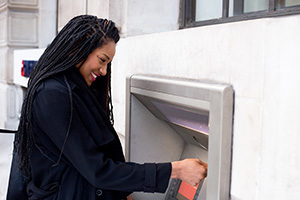
Does your savings plan match your lifestyle?

How to budget 101: 6 strategies to try

An emergency fund can help you cover an unexpected bill or survive a sudden job loss without having to resort to racking up a big credit card balance. Yet the majority of Americans don’t have enough money to cover three months of expenses. More than one in five have no emergency savings at all.
And even if you have emergency savings, you may not want to tap it for a home down payment, wedding expenses or another short-term goal. But building up a five-figure savings account, whether for emergencies or an upcoming planned expense, can seem like an impossible job. Where can you find room in your budget to cut back and free up money to save? Here’s how these super savers did it.
Kelly Anne Smith, who runs the finance and lifestyle blog Freedom In A Budget, has saved $10,000 in a single year twice: once to pay cash for her wedding and again to make a down payment on the home she and her husband bought. Cutting back on her grocery budget was her go-to starting point.
“I got hardcore on my groceries,” Smith says. She frequently shopped her own pantry and repurposed ingredients in multiple recipes to avoid food waste. “I was saving between $150 and $200 per month.” Other ways to slim down your grocery budget include smart coupon strategies, using apps to comparison shop and making fewer trips to the food store.
A typical family of four with a moderate grocery budget will spend around $1,200 a month on food at home, according to the U.S. Department of Agriculture. By shaving off $200 in monthly grocery spending, you could set aside $2,400 a year — nearly a quarter of a $10,000 savings goal.
Restaurants and takeout are another area that’s easy to cut back on to reach a major savings milestone. Martina A., a financial coach who shares her savings journey on her Stack Your Dollars blog, is a military wife who has saved over $10,000 every year since she and her husband got married. They rarely eat out to avoid overspending.
“Instead, we look up recipes for the food we’re craving and make it for much less,” Martina says. “It’s also fun and a great way to bond. Leftovers from our dinners are used for lunch the next day.”
You can unearth money to save by eliminating seemingly minor bills that you automatically pay every month. Take out your bank and credit card statements and look for recurring charges you can cut out. Eliminating this kind of mindless spending can be an easy way to free up cash.
A recent survey revealed that nearly half of people with streaming subscriptions pay for a service they don’t use. With many providers raising prices, now is a good time to audit your streaming services. But don’t stop with TV and movie services. Review your recurring app and media subscriptions and cancel the ones that don’t get much attention from you these days. Check to see if your bank’s mobile banking app can help you spot these kinds of charges.
Even when you’re in active saving mode, you may feel like you have major purchases you need to take care of. But that doesn’t mean you have to pay full price.
When Martina and her husband moved into a new apartment, they didn’t buy brand-new furniture all at once. “We moved across the country with only what fit in our car, then we took time furnishing it with good deals on secondhand furniture instead of buying everything right away,” she says.
Having sufficient insurance for your home and car is an important part of your overall financial security. But you can find ways to spend less on that coverage. The first is to raise the deductible on your policy. While you’ll be responsible for more charges if you need to file a claim, taking on that risk could significantly lower your monthly premium.
See if your carrier offers discounts for bundling all your coverage together. On the flip side, don’t feel like you must stick with the same carrier every year. Premiums vary widely among insurers, so compare policies annually to get the lowest price for the coverage you need. This is especially true when something changes like buying a new car, having an accident, or adding or dropping a driver.
Earning more money with a side gig is just as impactful as reducing costs when you’re trying to save a five-figure sum in a year. That’s a strategy Smith used on her path to $10,000 in savings. “Increasing my income with side hustles instead of solely relying on my day job was huge,” she says.
Smith launched a YouTube channel and set up an Etsy shop selling digital products. But there are plenty of side hustles that don’t require a big online audience. “Virtual assisting is the number one way to start if someone needs money fast,” Smith says.
Check platforms like Upwork and Fiverr to find opportunities. Smith also recommends offering personal assistant services via your local network. “There are moms who want help with stuff,” she says. “I would much rather hire someone to plan a birthday party than do it myself. Use the skills you have in your everyday life to help someone else.”
The sharing economy provides ways to increase your income by renting out things you already own. That includes renting an extra room in your home to visitors via services like Airbnb. If you don’t want to hang out with strangers, rent out your entire place one weekend a month while you go stay with family or friends (as long as your local laws allow it). For instance, by collecting $150 a night two nights a month, you could bring in $3,600 a year before taxes.
You can find apps that allow you to share your car or even a parking spot in your driveway or garage. To minimize disruptions in your life, you can create your own schedule for when the space is available.
About two-thirds of taxpayers receive a tax refund each year, and in 2023 that amount averaged $2,753. Instead of using the money to take a trip or make a large purchase, put it toward your $10,000 savings goal. The interest you earn on a certificate of deposit (CD) or money market account can boost your savings even further.
Setting aside an extra $10,000 in one year may seem unreachable, but there are many ways you can achieve this goal with just a few lifestyle changes.
Ready to start saving? U.S. Bank has a number of savings accounts to help you manage and grow your money.
Related content


